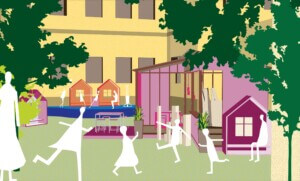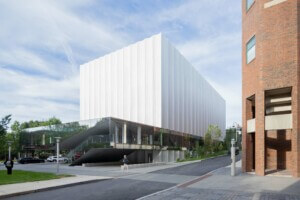The Techstyle Haus is an 800 square foot fabric house that uses 90% less energy thanks to a high performance double skin membrane with integrated PV.
Co-founded by Colin Touhey, Todd Dalland, and Robert Lerner, Pvilion is pioneering the design, engineering, fabrication, and installation of flexible solar solutions. For their 2014 Solar Decathlon project—a collaboration between RISD, Brown University, and University of Applied Sciences Erfurt (Germany)—Pvilion provided engineering consulting services on the structural design and membrane roof system. The project team questioned if a membrane roof house could be designed to meet strict passive house energy codes. The answer was a resounding yes—what came to be known as the Techstyle Haus is currently the only fabric structure that meets passive house standards, producing 50% more energy than it consumes. The house was originally constructed in Providence and then disassembled, placed in crates, and shipped to France for relatively easy re-assembly at Versailles. Currently, the Techstyle Haus resides at Domaine de Boisbuchet, the site of an annual art and design workshop, where it serves as a living laboratory and teaching tool as well as student housing. An in-depth video of the design can be viewed here.
Colin Touhey, co-founder of Pvilion, said this project is a proof of concept for their flexible, scalable solar solutions. “Given the curvature of the form, the building produces more energy than flat or angled solar arrays.” Techstyle Haus was designed in concept to embrace a double skin tectonic. It’s PV modules are encapsulated in a thin sheet of plastic allowing for a lightweight assembly of shallow curves and folded surfaces.
PV’s are typically very labor intensive as each 3’x5’ panel has to be individually wired. Touhey says by eliminating a significant amount of the “stuff” that goes into a traditional solar array can offer design flexibility along with cost savings: “the more that can be integrated into the off-site fabrication process, the cheaper and more effective the system will be. Also, we have found if you eliminate the frames from a PV, if you eliminate the glass from the PV, and if you laminate the PV into a light material, you can ship more of it in one container. All of these variables add up on a very large scale.”
- Facade Manufacturer
St. Gobain (inner skin); Pvilion (outer skin) - Architects
RISD/Brown/Ehrfurt - Facade Installer
Birdair (primary facade); Pvilion (solar facade installer) - Facade Consultants
Pvilion - Location
Providence, RI / Versailles, France / Lessac, France - Date of Completion
2014 - System
flexible fiberglass membrane with PV fabric on steel frame - Products
Pvilion PV Fabric, Sheerfill II Architectural Membrane, with EverClean Photocatalytic Topcoat
Building Integrated Photovolatics (BIPV) have become an increasingly significant topic within the advanced building systems design and construction community. Rather than treating PV as an additive system requiring a separate metal support structure superimposed on a building’s roof, BIPV is an evolving practice of incorporating custom solar technology into the constructional logic of a structure. Often, BIPV projects see cost savings through the replacement of roofing tiles or other building elements with photovoltaic panels.
The 2014 solar decathlon was held in Versailles, France, and included 20 prototype structures from 16 different countries. From these projects, 11 prominently utilized BIPV strategies. In addition to Pvilion’s flexible solar fabric, other approaches included cantilevered lightweight shading elements, solar-integrated glazing, a colorful lightweight PV roof, and numerous roof-mounted configurations. In a statistical analysis conducted by a team of researchers at Jaume I University (Castillo, Spain), and published by Advanced Building Skins GmbH, the Techstyle Haus was rated as one of the “most pleasurable BIPV solutions.”
Robert Lerner, a co-founder of Pvilion, explains the value of lightweight solar fabric for large commercial applications: “we developed a way to put photovoltaic sheets as a secondary membrane onto a primary membrane. the primary roof skin will almost always be a costly, durable product. Consider a 50 year Teflon-coated glass fabric under very high pre-stress for long spans. Our lightweight membrane can be replaced in 20 years if necessary without affecting the roof below it.”
Half of Pvilion’s projects are facade-related while half are completely unrelated lightweight temporary and permanent structures—from outdoor clothing apparel to parking canopies and infrastructural projects. Touhey says their goal is to take the Techstyle Haus’ system—an interior skin, exterior membrane, insulation, PV, and wiring – and scale it up to a significantly larger context.
Upcoming projects include the Artist for Humanity Headquarters in Boston—a renovation and expansion of and existing building into a structure 5 times as large as the original. Once complete, it will be the first net energy positive large commercial project on the East Coast. The building will feature a solar wrapper that doubly functions as a passive shading element integrated with flexible monocrystalline photovoltaic cells. Other applications include flexible installations on perforated aluminum and warped steel panels, both with free-form perimeters and curved surfaces. Lerner says this is where flexible solar technology shines, “This indicates the freedom of design that is possible while incorporating conventional facade materials.”










